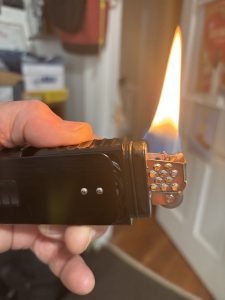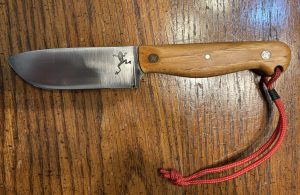
ARE YOU RAPIDS-SMART?
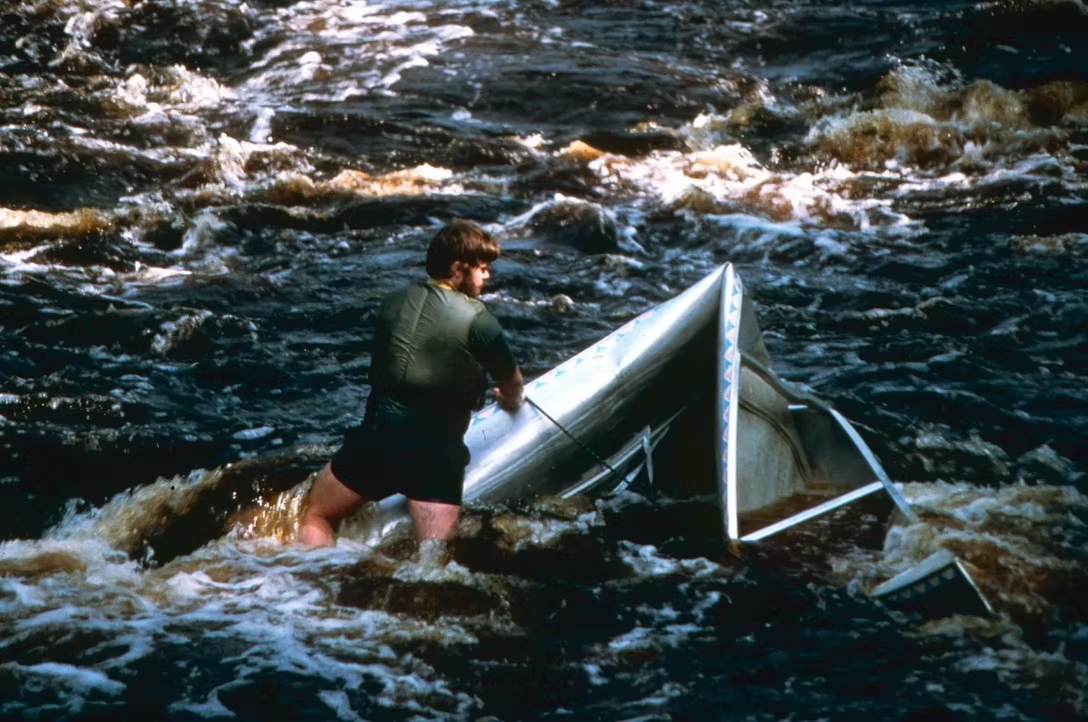
Alumacraft 17′, “wrapped.” Hells Gate, Kettle River, MN.
This canoe is being salvaged so it won’t pose a danger (obstacle!) to paddlers.
Round the bend you see the dancing horsetails of the rapid. As is the stern’s prerogative, you command the bow to “brace” so you can stand for a better look. The way ahead looks clear, so you settle to your knees and power towards the slick water vee which defines the route. Suddenly, a huge rock pillow looms out of nowhere; the bow misses his cue, draws too late, and the tottering craft dives into the yawning hole below. Capsize! Seconds later, paddlers and gear are immersed in the chilling grip of moving water.
This irresponsible scenario is played again and again on rivers everywhere. Canoeists approach a drop, survey it briefly from above, then dash jubilantly downstream. Often, luck prevails, and everyone simply has a splashing good time. But not always. As this classic case illustrates, unplanned upsets can be fatal:
It was September 14,1955 on the Dubawnt River in the Northwest Territories, and already, there was a crispness in the air. Each day, frost grew heavier on the morning ground. Arctic summer, so intense in early August, was gone now, and autumn with its sub-freezing temperatures and fierce polar gales had begun. Thirty-six-year-old Arthur Moffatt was leading five young men, ages 19 to 21, on a traverse of the barren lands. They had begun at Stoney Rapids, Saskatchewan on June 29th and were bound for Baker Lake.
From the diary of Joe Lannouette, published in George Grinnell’s book, A Death on the Barrens, Northern Books 1996:
September 14th: “This has been the most harrowing day of my life. It started as many others: bleak and dismal under a cover of clouds. It was below freezing and the sand was crunchy and hard from its layer of frost and ice. After a fine lunch of fish chowder, we shoved off again at around 2:30. In a few minutes we heard and saw rapids on the horizon. At the top, the rapids looked as though they would be easy going, a few small waves, rocks –nothing serious. We didn’t even haul over to shore to have a look, as we usually did. The river was straight, and we could see both the top and the foot of the rough water quite clearly, or we thought we could. ..”
Almost immediately it happened. Two canoes swamped and the third almost did. At one point five men were swimming in the ice-cold water. The rescue dragged on and on. Ultimately, they all reached shore, bitterly cold. We can only speculate why Moffatt died of hypothermia, but his friends did not. George Grinnell’s account of their ordeal makes it clear that they all could have easily perished that tragic day.
Arthur Moffat was buried at Baker Lake in the land he loved best. A simple wooden cross in a lonely cemetery marks his grave.”
From my flagship book, Canoeing Wild Rivers, 5th Edition.
Art Moffat made several serious errors, all of which are easily avoided by perceptive men and women with cautionary sense. Most unforgivable was recklessness – failure to scout a rapid from top to bottom before running it. Second, was a lack of planning. Indeed, Moffat’s diary, which was later published in Sports Illustrated magazine, gave no indication that he had a travel schedule at all. There was no battle plan in the event of an “upsetting experience,” and no respect for the dangers of ice-cold water. No one in Moffat’s crew understood the nature of hypothermia or knew how to treat it.
White water thrill seekers take to the river as soon as the ice melts in early spring. Clad in wet (or dry) suits and helmets and secured to their boats with thigh straps and toe blocks, they play confidently in drops that flat-water canoeists portage around.

A properly outfitted whitewater canoe and paddler. Note helmet, PFD, float bags.
Even if you don’t paddle serious rapids, you’ll benefit by knowing the ways of whitewater sport paddlers. But keep an open mind as you learn, for what works best in a short, sport canoe can be dangerous in a long backwoods cruiser. There’s a proven method to getting safely down the rapids of an unfamiliar river. Here are some of the rules for safe passage:
When you see the dancing horsetails of a rapid, put ashore immediately, on the inside bend (more on this later) of the river and scout the entire drop. Shorelines are often brushy and difficult to travel so this advice is not always easy to follow. Often, you may have to horse your way through shoulder-high willows, jump from rock to rock, or cross a patch of knee-high mud, all the while sweating and swatting hordes of mosquitoes and black flies. Nonetheless, you must avoid the temptation to abandon the project and “go for it,” even on a river you have paddled many times. Indeed, “familiar rivers” may be the most dangerous rivers of all, as the following case illustrates:

Cliff, scouting a questionable rapid. MacFarland River, Saskatchewan.
This rapid ends at Lake Athabasca.
It was my fourth descent of Saskatchewan’s Fond du Lac River. The “always canoeable” class III rapid was etched clearly in my mind. Begin far right, clear the narrow chute below, then pivot quickly upstream and ferry across to river left. Just before crashing the bank, turn down current and catch the yard wide slot near shore. High water will make the run easier, but it’s possible if there is any downstream flow. Still smarting from the hurt of wrapping my Mad River Explorer earlier that summer (on a river I’d done five times before!), I decided to walk the right bank and check for obstacles in the ferry path. There were none. However, to see the negotiable slot, I’d have to ferry across river then walk 200 yards on precarious boulders. Why mess around for 30 minutes to ascertain what I already knew? Hadn’t I faithfully walked the right shore and satisfied the need for caution? After all, I’d safely run this rapid three times before.
Further checking would surely be a waste of time.

ABOVE AND BELOW: My wrapped Mad River, Kevlar Explorer. Steel River, Ontario. Yes, it was salvageable. When we extracted it from the boulder, it popped right back into shape – wood gunnels intact, no leaks. A weekend’s work at home and that boat was good to go.
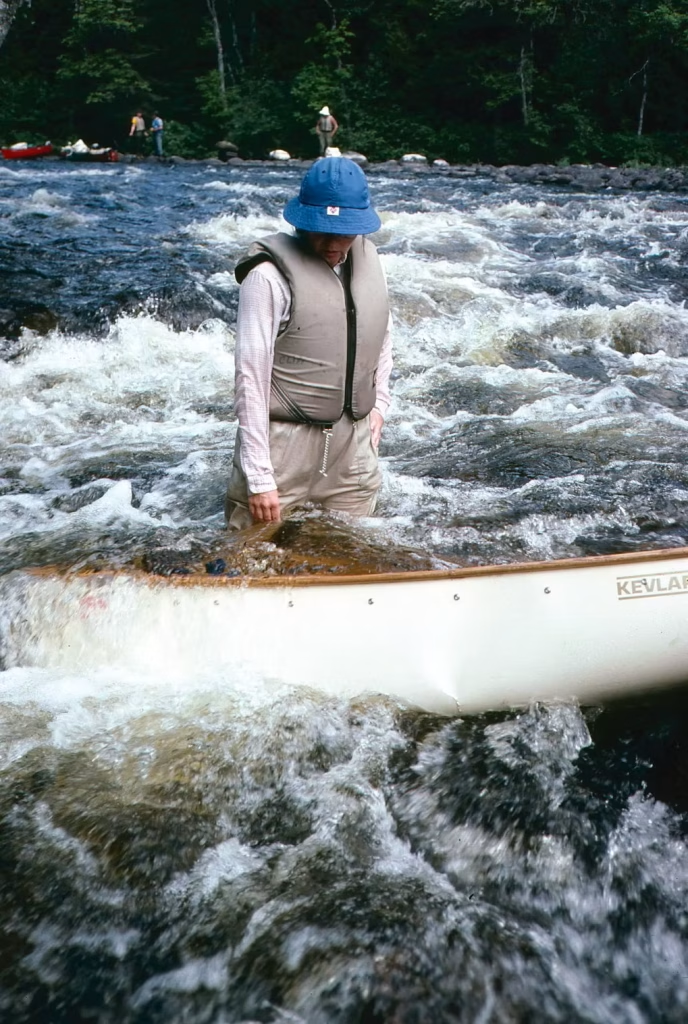
Or would it?
In a far corner of my mind, my conscience begged the need for caution. Should I heed the call and take the time to scout? Longingly, I stared at the blind spot which marked what experience had revealed was a clear channel. Again, I remembered my upsetting experience earlier that year. Time be damned: I would not run this rapid until I checked the chute!
Dutifully, I ferried across the prancing rapid and tied up to the gnarled bole of a wind-beaten spruce. Numbly, I boulder-hopped to the final drop, confident I was in for no surprise. Then I saw it – a two-inch trickle of water marked the vee of the “always canoeable” chute. Horrified at what might have been, I mentally played out the scenario: Coming out of the fast forward ferry, we’d spin downstream into nothingness and capsize in the heavy water which pounded the boulder line below. There simply was not enough water for a clean run. It took less than five minutes to line my canoe to safe water below.
If I could teach just one skill to those who paddle straight-keeled cruising canoes down fast-moving rivers, it would be the backferry. In this technique, paddlers maintain a downstream attitude and angle their canoe about 30 degrees to the current-tail pointing in the direction they want to go. As they paddle backwards, the canoe moves sideways (no downstream motion) across the river to the safety of an eddy. You’ll find the rules of playing this unique vector game in every basic river canoeing text.
Hot dog whitewater paddlers do not back ferry. Instead, they spin their short, highly-rockered canoes upstream and forward ferry across the river from eddy to eddy. Try this in a lively rapid with a heavily loaded cruising canoe and you’ll bring home the remains of your canoe in a suitcase!
It follows that you should always ferry to the inside bends. Rivers run faster on the outside curves and all the waves pile up there. And if you do have to portage, the inside bend defines the shortest distance between points – the reason why established carries are almost always found here.
The nine out of ten rule: Many backcountry trippers apply the “nine out of ten” rule before they commit to a rapid. Can you successfully run this drop nine out of ten times? If not, better line or portage.
Scenario: Your partner wants to run the rapid. You don’t. Here’s how to support your position.
“Well, John, it’s your boat. I won’t take responsibility for what it looks like when we reach the bottom.”
Conversely, “Sorry, John, it’s my boat. I can’t afford to buy a new one!
Or best of all: “I trust you, John, but I don’t trust myself. I’m not up to this and I don’t want to let you down.
Whitewater novices are often overwhelmed at the size and complexity of a long, thundering rapid. At first look, there seems no alternative but to portage. But once you learn to dissect the rapid into “manageable pieces” by scouting each obstacle from eddy to eddy, options abound.
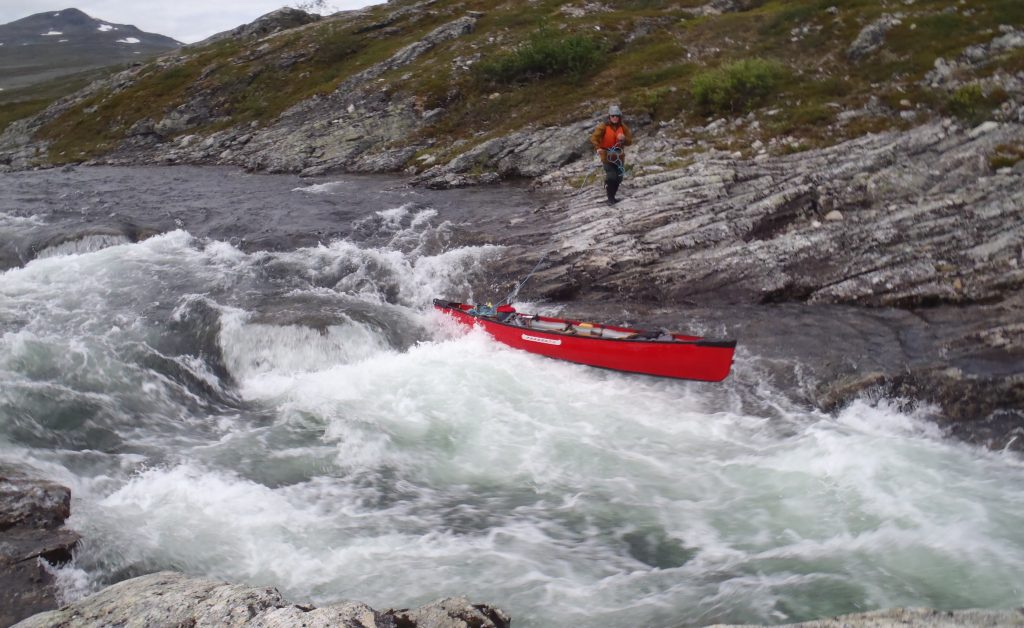
This rapid was scouted from shore, then lined through a shoot on the left. The rest of the rapid below was canoeable. Latiseino River, Norway. 14-foot Pakboat (folding canoe). Cliff, lining.
For example: Run to the eddy on the left then drag over the rocks to the clear channel at right. Then, line down through the shallow rock garden to the clear vee, then run to the next eddy. Tie up here, then have a closer look at what’s downstream. This “bits and pieces” approach pays rich dividends in negotiating long rapids which continue around bends.
In summary, hug the inside bend (a reliable back ferry is essential!!) when you hear menacing rapids. Then, put ashore and scout! Respect rivers you’ve done before: complacency can be deadly – high water, low water, and strainers (downed trees) create new hazards. Learn to identify the roar of bad rapids and the sight of lethal ledges. Finally, apply the nine out of ten rule before you run any rapid. If in doubt, line or portage!
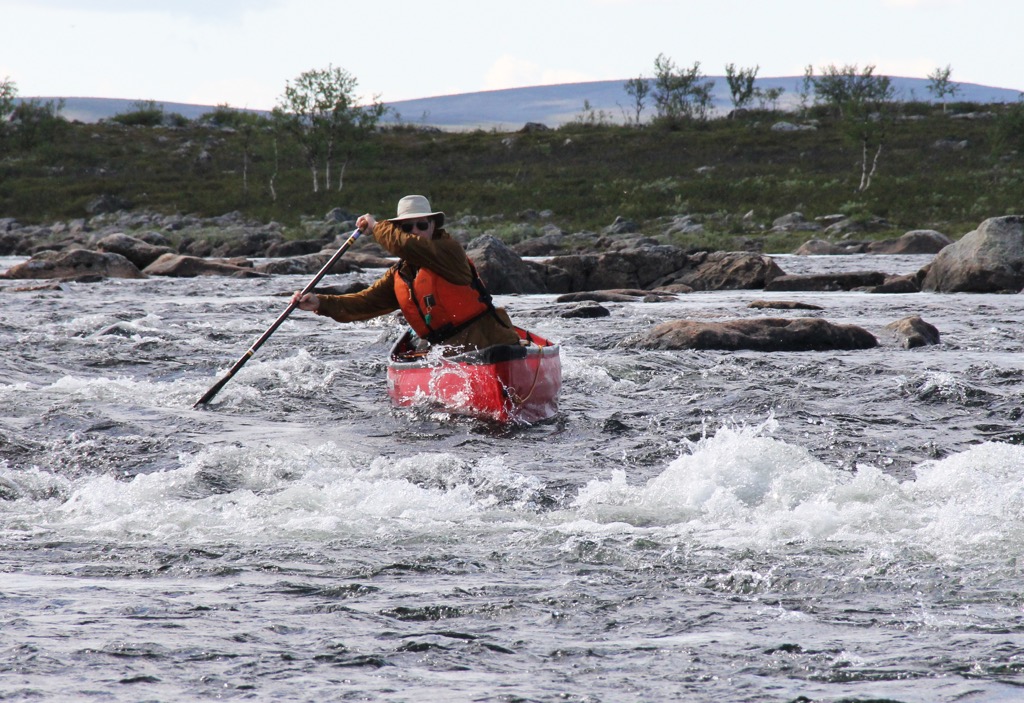
This is the lower end of the above rapid. It was canoeable. Cliff holding a “high brace.”
——————————————–
*My flagship book, CANOEING WILD RIVERS, 5th Edition, contains a wealth of advice on how to safely canoe difficult rivers.
*My teen book, JUSTIN CODY’S RACE TO SURVIVAL! mixes a fictional wilderness survival tale with practical outdoor skills everyone should know – a first for books of this type. Adults love it too!
*My long out-of-print book, CANOEIST’S Q&A (available as an e-book and Audible) contains 25 true scenarios (plus FAQ’s) that define the wilderness canoeing and camping experience – a great training tool for those who go beyond the beaten path.
*My latest book CAMPING’S TOP SECRETS, 5th Edition, details practical camping tips and procedures that only the experts know. If you know just a few of these tricks, you’ll be a hero to your friends!

